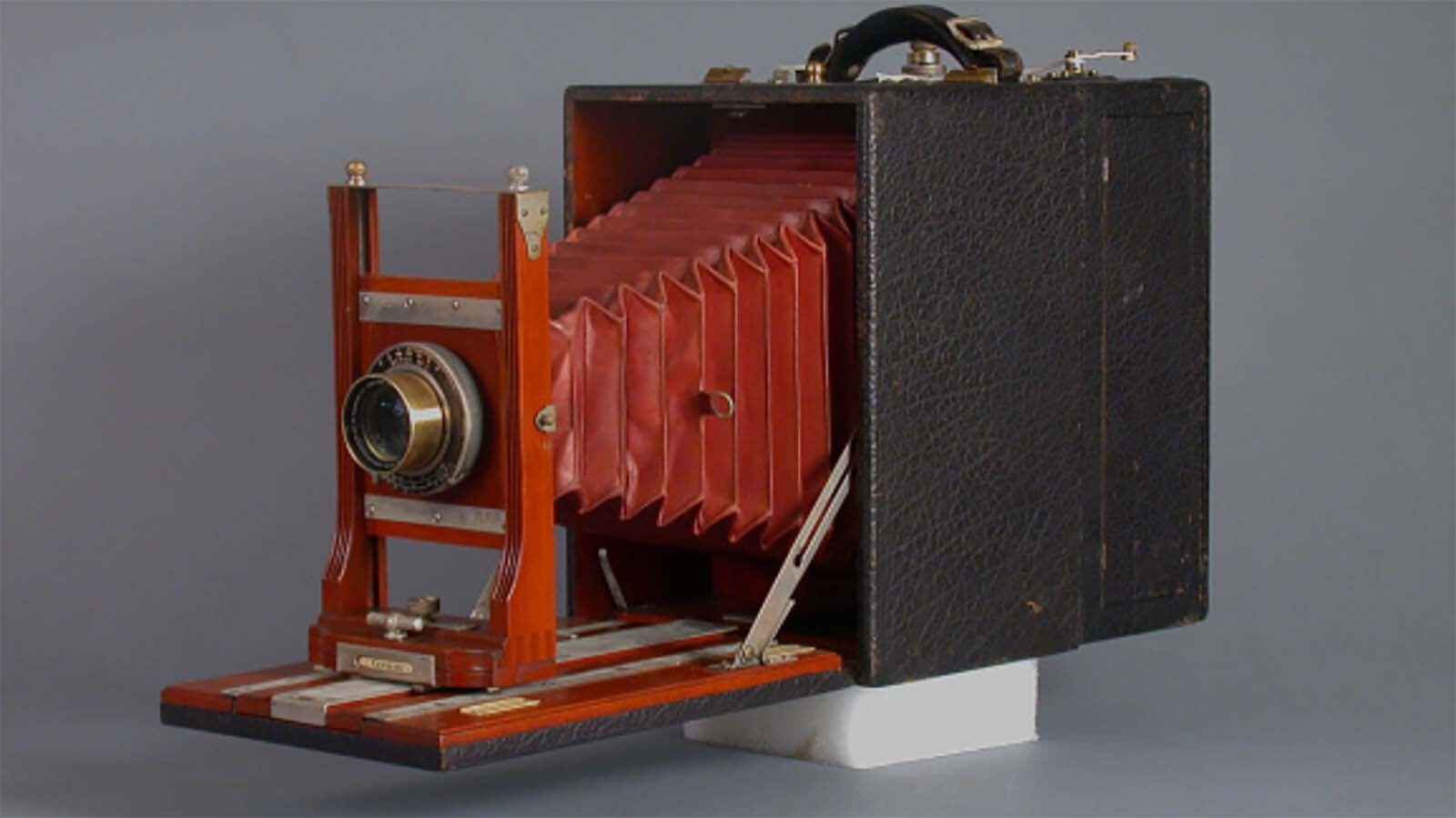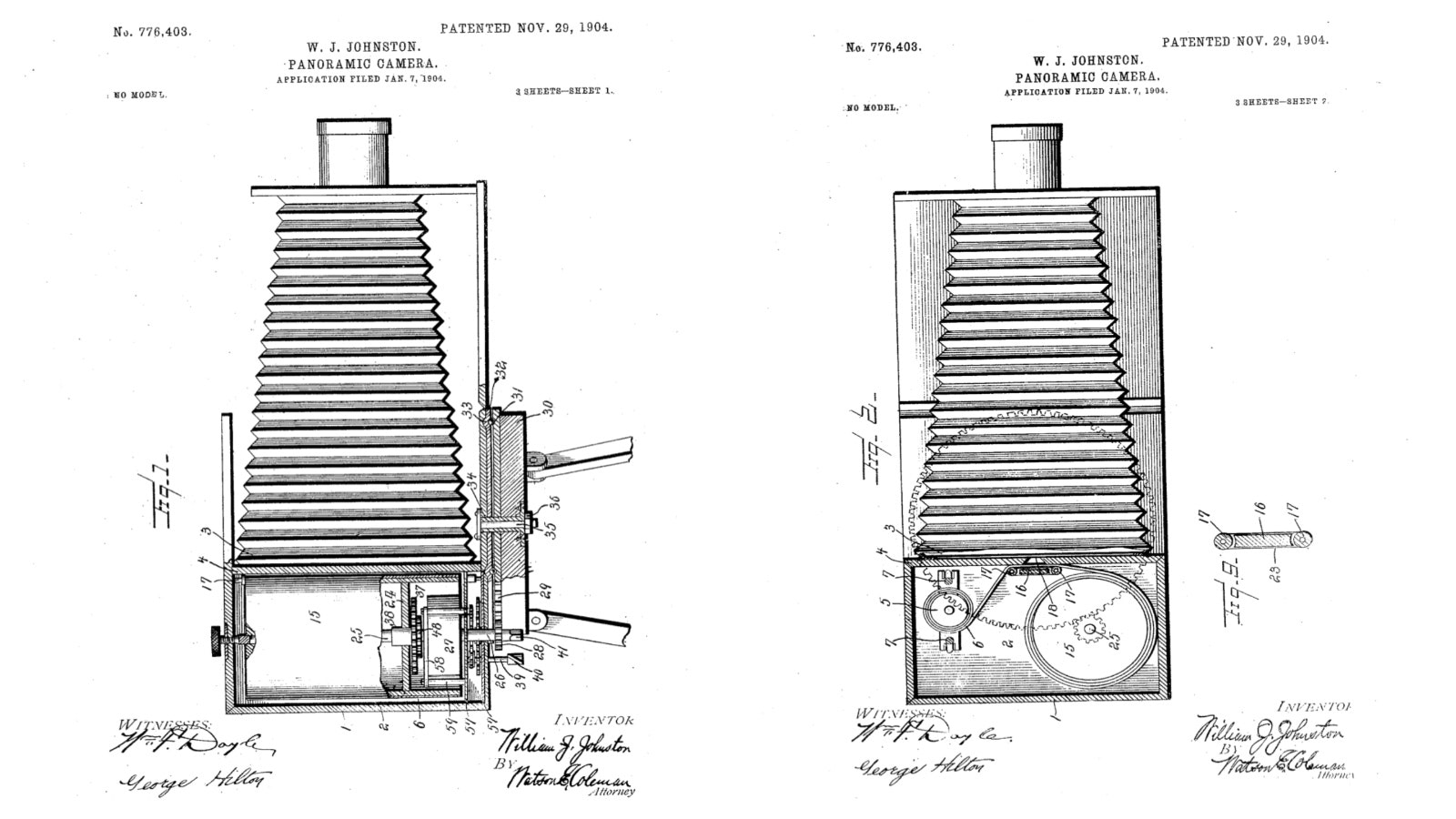A Canadian native who spent years in Wyoming capturing iconic photos of Native Americans helped revolutionize the art of photography by developing a camera that swiveled with a motor to take panoramic photos.
William J. Johnston’s “panoramic camera” patent application that he filed as a resident of Rock Springs on Jan. 7, 1904, was meant to improve panoramic cameras and was approved by the U.S. Patent Office on Nov. 4, 1904, according to the U.S. Patent Office.
The next year, on Jan. 17, 1905, a patent was approved for his “camera revolving apparatus” that was “free in operation from vibrations and consisting of the minimum number of parts.”
Sweetwater County Historical Museum spokesperson Dick Blust said he was doing research and discovered Johnston’s connection to Rock Springs and panoramic cameras. He created a post for the museum’s Facebook page about the county’s former resident.
“It was just fascinating to learn about panoramic cameras and how they worked,” he said. “You can do that on most smartphones now, but in those days, it was very mechanical.”
Johnston’s patent application for the camera said that his invention allowed for “a continuous panoramic view of any scene within a circle or any portion of a circle (that) may be produced.”
The patent also described how the camera was designed to combine “utility with compactness” and offer users a device that was “simple in construction, practical and easy of adjustment,” he wrote.
Blust said his research showed that the Cirkut camera that was developed sat on a chrome disk, had a clockwork motor and rotated.
The film was designed to roll from a spool past the shutter and onto the take-up drum in varying lengths. He said once the shutter was tripped, the camera rotated smoothly exposing the film that was on a roll inside the camera.
“It has all kinds of adjustments and settings, but you wind it up like a clock,” he said.
Johnston’s patents apparently involved an effort to create a company as well as produce his camera.
Rochester Panoramic Camera Co.
By 1905, Johnston had moved from Wyoming, but his connections to Rock Springs involved local investors in a company called the Rochester Panoramic Camera Co. of Rochester, New York.
The Official Gazette of the U.S. Patent Office on Jan. 17, 1905, listed the Panoramic Camera with the name of David A. Reaville and noted that the patents associated with the camera were being assigned to the Rochester Panoramic Camera Company of Rochester, New York and stated that it was a corporation of Wyoming.
Reaville was an attorney in Rock Springs at the time.
The Rock Springs Miner reported on April 8, 1905, that the Cirkut camera was being manufactured by a company “composed principally of Rock Springs men.”
“The invention of Mr. Johnston has created much discussion on the part of the expert photographers of the world, and it is the consensus of opinion that the Cirkut is the nearest to perfection of any camera on the market,” the newspaper stated.
The Fort Wayne Journal Gazette in Fort Wayne, Indiana posted a story on Feb. 8, 1905, about the Rochester Panoramic Camera Company’s product.
“This camera is built to take in a view as great as the eye can comprehend from one point and is assuredly a marvel of its kind. It is going to revolutionize photography, especially in the taking of large groups and extensive landscapes,” the newspaper wrote.
However, the company did not last long and was taken over by the end of the year by the Century Company, according to author Rudolf Kingslake, who wrote about the company in the book, “The Rochester Camera and Lens Companies.”
Just two years after that, the Century Company was acquired by Eastman Kodak.
David Firman, a Manitoba, Canada, photographer who wrote a blog about the Cirkut cameras posted a sales brochure from that time that explained Kodak’s reason for acquiring the company.
“The Cirkut photographer is not hampered by the limits set by the size of his camera. He can make his negative as long or short as may be required to produce the best pictoral effect,” the brochure stated. “He can include in his view any angle, even the complete circle of 360 degrees, and all on daylight loading Eastman film.”
Faded Glory
Though the Cirkut technology would be improved on and several Cirkut cameras developed that were named based on the width of the film used, the camera hit its height of popularity, and sales began to fade by the 1920s. Kodak sold the division that made the cameras in 1926, but a version of the Cirkut cameras continued to be manufactured until 1945, Firman wrote.
Pinedale-based photographer Dave Bell, who travels the western United States capturing its beauty, said while today three clicks with Photoshop software allow him and other photographers to put together a panoramic scene, Johnston’s invention must have “blown minds back then.”
Bell said in the early 1900s, photographers were still putting the hood over their head and tripping the camera shutter while hoping their flash synced to capture their subject.
He said he recently returned from a trip on the Missouri River where he was retracing part of the Lewis and Clark expedition where famous artists in the 1870s painted panoramic scenes recapturing the beauty.
“If you were back East and you would have seen pictures of a panoramic nature of what Lewis and Clark were seeing on their trip, that would have been again a mind-blowing experience,” he said. Bell said he was not aware of Johnston or the Cirkut cameras but assumes the photos they produced “would have been of great novelty to people.”
Blust said another fascinating thing his research uncovered was that not only did Johnston invent his panoramic camera, but he also partnered with a photographer in Evanston, Charles Baker in the late 1880s to capture images of native Americans.
“The photograph of Chief Washakie, you see everywhere is theirs,” Blust said. “And that’s an iconic photograph.”
Native American Photos
The University of Wyoming’s American Heritage Center Assistant Director William Hopkins said they did not have information on Johnston’s invention, but they had 77 original glass plate negatives and copy prints of native Americans primarily from the Shoshone, Arapaho, and Apache tribes that Baker and Johnston photographed.
“They are incredibly important historically because they provide us with a connection to the past, like any and all historic photographs they are a window on the past,” he said.
Among the photos captured by the pair in addition Chief Washakie, were photos of General Crook, an Arapaho camp, and an iconic image of the Apache military leader Geronimo.
Early newspapers in Rawlins, Rock Springs and Evanston mention W. J. Johnston and his work in the area.
In 1885, the Carbon County Journal reported that the photographer was in Rawlins.
“Mr. W. J. Johnston of the well-known photographic firm of Baker & Johnston, came down from Evanston the first of the week to spend a few days in a live town,” the newspaper wrote. “His studio will be down here in the course of a month.”
In 1891, the Cheyenne Daily Sun reported that Johnston was aboard a newly christened steamer the Major Powell with an assignment to capture photos of a trip the new crew was taking down the Green River to the Colorado River.
In 1892, The Rock Springs Miner reported that Johnston was in Lander in Fremont County and had sent an associate back to Rock Springs to get more photographic equipment.
“Mr. Johnston is doing a rattling business,” the newspaper reported.
The Evanston Register on July 22, 1893, reported that Charles Baker was headed east to Ohio for a visit and in his absence, his former partner W. J. Johnston would run his studio.
The Rock Springs Miner reported on Feb. 28, 1895, an item in the Rawlins Journal that Johnston had decided to open a “photography gallery” above the Rawlins drug store building. “His family will arrive in a few days, but he will remain permanently,” the Rawlins paper reported.
In the 1900 census, Johnston was reported living in Rock Springs, and it listed him as married to Margaret Johnston. He was listed as 43 years old.
But by 1906, Johnston and his family were apparently living in Toronto. The Rock Springs Miner reported that Mrs. C. C. Freeman and her children had traveled there to be the guests of the Johnston family.
Dale Killingbeck can be reached at dale@cowboystatedaily.com.














